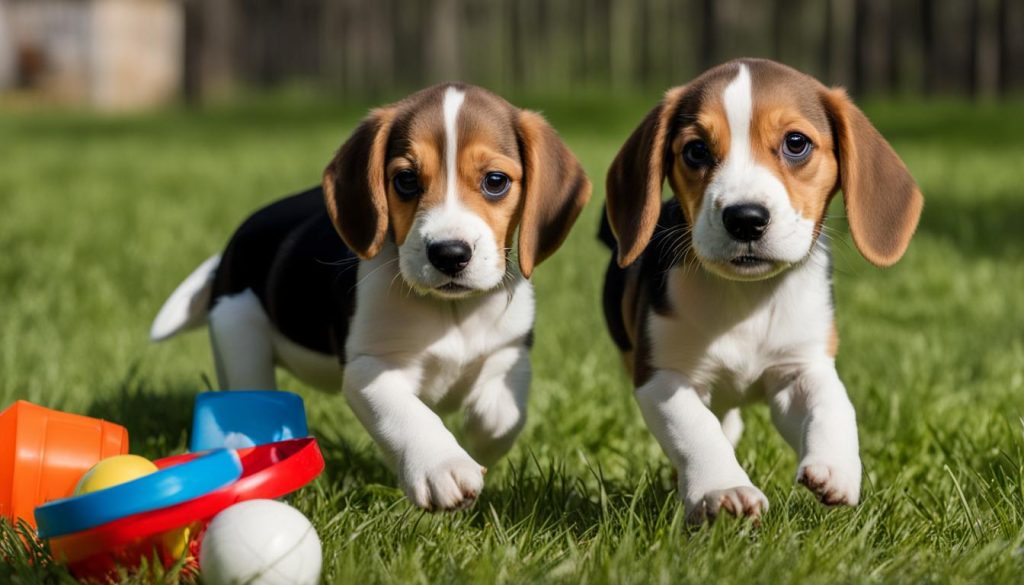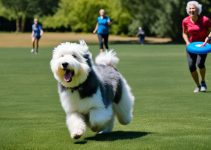Training a Beagle can be a challenge, especially for first-time owners. However, with the right strategies and techniques, you can ensure that your Beagle becomes a well-behaved and obedient companion. Here are some essential training tips for first-time Beagle owners based on factual data.
Unraveling Beagle Training
- Start training your Beagle puppy early to establish good behavior and prevent bad habits.
- Use positive reinforcement techniques and be patient and consistent with their training.
- Introduce crate training to provide your Beagle with a safe and cozy space.
- Create a consistent potty training schedule and reward good behavior.
- Teach basic commands and leash training using positive reinforcement.
Start Training Your Beagle Puppy Early
When it comes to beagle training, starting early is key. It is recommended to begin training your Beagle puppy as early as 7 to 8 weeks old. Beagles are known for their intelligence and curiosity, which means they can quickly pick up new commands and behaviors.
Early training not only helps your Beagle develop good behavior, but it also prevents the development of bad habits. By establishing a strong foundation of training early on, you can ensure that your Beagle grows up to be a well-behaved and obedient companion.
So, how do you start training your Beagle puppy? First and foremost, use positive reinforcement techniques. Reward your puppy with treats, praise, and affection whenever they exhibit the desired behavior or follow a command correctly. This will help them associate training with positive experiences.
Consistency and patience are also crucial during the training process. Beagles thrive on routine, so create a consistent schedule for training sessions and stick to it. Make sure that everyone in the household follows the same training techniques to avoid confusion for your puppy.
Remember that each Beagle puppy is unique, so be patient and adapt your training approach to their individual needs. Some Beagles may require more time and repetition to grasp certain commands or behaviors, while others may pick up on them quickly.
In addition, it’s important to provide mental and physical stimulation for your Beagle puppy. They have a natural instinct for hunting and exploring, so incorporate interactive toys and games into their training routine to keep them engaged and prevent boredom.
Tips for Successful Beagle Puppy Training:
- Start training early, ideally between 7 to 8 weeks old
- Use positive reinforcement techniques, such as treats and praise
- Be consistent and patient with your training sessions
- Create a consistent schedule for training sessions
- Adapt your training approach to your Beagle puppy’s individual needs
- Provide mental and physical stimulation through interactive toys and games
Remember, beagle puppy training is a process that requires time, effort, and consistency. With the right techniques and a positive attitude, you can set your Beagle puppy up for success and enjoy a well-trained and happy companion.

Establish Crate Training for Beagle Puppies
When it comes to Beagle training, crate training is an essential technique that every owner should consider. Crate training provides your Beagle with their own safe and cozy space, which helps to prevent disruptive behaviors when they are home alone and reduces anxiety. Introducing the crate gradually and making it a positive experience for your Beagle is key to successful training.
Start by placing the crate in a quiet and comfortable area of your home. Ensure that it is well-ventilated and spacious enough for your Beagle to stand, lie down, and turn around comfortably. Line the crate with a cozy blanket or bed to make it inviting.
Use treats and rewards to encourage your Beagle to enter the crate. Start by tossing a treat inside and letting them go in voluntarily. Once they are inside, praise them and give them another treat. This positive reinforcement helps them associate the crate with positive feelings. Gradually increase the amount of time your Beagle spends in the crate, always rewarding them for good behavior.
Remember to never use the crate as a form of punishment. It should be a safe and comforting space for your Beagle, not a place they fear. Avoid leaving your Beagle in the crate for extended periods of time, as they need regular exercise and human interaction.
Crate training is especially useful for house training your Beagle. Dogs naturally avoid soiling their sleeping area, so the crate can help establish a routine for potty training. Take your Beagle outside to their designated bathroom spot immediately after they come out of the crate. This helps them associate the crate with the need to go potty and reinforces good behavior.
Remember to be patient and consistent with crate training. Each Beagle is unique and may take a different amount of time to adjust to the crate. With time and positive reinforcement, crate training can become a positive and beneficial part of your Beagle’s training journey.
Tips for successful crate training:
- Introduce the crate gradually and make it a positive experience with treats and rewards.
- Ensure the crate is comfortable and well-ventilated.
- Avoid using the crate as a form of punishment.
- Establish a routine for potty training using the crate.
- Be patient and consistent with the training process.
Potty Training Your Beagle
Potty training your Beagle doesn’t have to be stressful. With a consistent approach and positive reinforcement, you can successfully train your Beagle to go potty in the right place.
Creating a regular potty schedule is crucial for beagle house training. Take your Beagle pup outside to their designated potty area at consistent times throughout the day, such as after meals or naps. Use a verbal cue like “Go potty” to associate the act with the command. Be patient and give your Beagle enough time to eliminate.

When your Beagle successfully goes potty in the designated area, be sure to reward them immediately with treats and enthusiastic praise. This positive reinforcement helps reinforce the behavior and encourages them to repeat it.
If you live in an apartment or have limited outdoor access, you can consider using puppy pads as an alternative. Place the puppy pads in a designated area indoors and encourage your Beagle to use them for potty breaks. Gradually transition them to outdoor potty training when possible.
Consistency is key to successful beagle potty training. Establish a routine, praise and reward your Beagle for good behavior, and be patient throughout the training process. With time, your Beagle will learn where and when to go potty, leading to a well-behaved and housebroken companion.
Teach Basic Commands and Leash Training
When it comes to Beagle training, teaching them basic commands is an essential part of their development. Commands like “sit” and “stay” not only help establish boundaries but also ensure their safety in various situations. To effectively train your Beagle in basic obedience, it is important to use positive reinforcement techniques.
Start by breaking the training sessions into short and frequent intervals. Beagles have a tendency to get easily distracted, so keeping the sessions brief will help maintain their focus. Always remember to reward your Beagle with treats and praise when they successfully follow a command. This positive reinforcement encourages them to repeat the desired behavior.
Additionally, leash training is crucial for ensuring your Beagle’s obedience and safety while out on walks. Begin leash training early in their development and introduce the concept gradually. Start by using a lightweight leash and let them get accustomed to wearing it. Over time, gradually increase the duration and distance of walks while keeping a calm and patient demeanor.
During leash training, it’s important to strike a balance between giving your Beagle some freedom to explore and maintaining control. Guide them gently using the leash, and reward good behavior with treats and praise. This positive reinforcement will help them associate walking on a leash with positive experiences.
Remember, Beagle training requires patience and consistency. Celebrate small victories along the way, and don’t get discouraged by setbacks. With time and positive reinforcement, your Beagle will become a well-trained and well-behaved companion.
Training your Beagle in basic commands and leash training is an essential part of their overall behavior training. By using positive reinforcement techniques and gradually introducing them to walking on a leash, you can ensure that your Beagle becomes a well-behaved and obedient companion.
Professional Beagle Training and Conclusion
If you find that training your Beagle is challenging or you don’t have enough time, consider seeking help from professional dog trainers. They have the skills and knowledge to guide you in finding effective beagle training techniques and teach your Beagle the right manners. Professional beagle training classes can provide a structured environment for your dog to learn and socialize with other dogs.
Remember that training takes time and patience. Consistency is key when teaching your Beagle, and positive reinforcement goes a long way. By using rewards, praise, and love, you can encourage your Beagle to learn and exhibit good behavior. With professional guidance and your dedication, you can have a well-trained and well-behaved Beagle as a loving companion.
In conclusion, professional beagle training can be a valuable resource for first-time owners or those facing challenges in training their Beagles. The expertise of professional trainers combined with your commitment can lead to successful training outcomes. By implementing effective techniques and maintaining consistency, you can enjoy a lifelong bond and a harmonious relationship with your four-legged friend.
FAQ
When should I start training my Beagle puppy?
It is recommended to start training your Beagle puppy as early as 7 to 8 weeks old.
What training techniques work best for Beagles?
Positive reinforcement techniques, such as using treats and rewards, work best for training Beagles.
How important is crate training for Beagle puppies?
Crate training is essential for Beagle puppies as it provides them with their own safe and cozy space.
How can I potty train my Beagle?
Create a consistent schedule for your Beagle puppy and reward them with treats and praise when they go potty in the designated area.
How do I teach my Beagle basic commands?
Use positive reinforcement techniques and break the training into short and frequent sessions to teach your Beagle basic commands.
Is professional training recommended for Beagles?
If you find training your Beagle challenging or don’t have enough time, seeking help from professional dog trainers is recommended.






